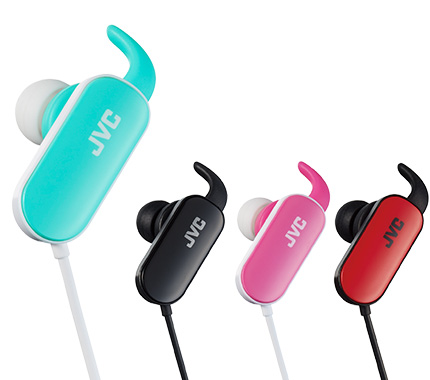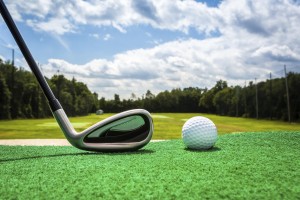- Book Reviews SCAVENGERS by Kathleen Boland
- Book Reviews THE FIRST TIME I SAW HIM by Laura Dave
- Book Reviews THE BOOKBINDER’S SECRET by A.D. Bell
- Book Reviews HOMEBOUND by Portia Elan
- Book Reviews THE HEIR APPARENT by Rebecca Armitage
- Book Reviews THIS IS NOT ABOUT US by Allegra Goodman
- Book Reviews STORM WARNING by James Byrne
- Children's Book Reviews THERE’S NO PLACE LIKE GNOME by Scott Magoon (picture book)
- Children's Book Reviews OUR AIR by G. Brian Karas (Picture Book)
- Book Reviews DETOUR by Jeff Rake and Rob Hart

Can Your Bluetooth Earbuds Survive My Golf Swing?
Disclosure: We received a set of HA-EBT5 Bluetooth Sport Earphones in order to facilitate this review. All opinions are our own.
A few weeks ago, JVC asked me to review their HA-EBT5 Bluetooth sport earphones. My response was a bit terse, “I’ve tried numerous Bluetooth earphones and they all have two major flaws – I can’t keep them connected to a sound source (spotty Bluetooth) and I can’t keep them in my ears during my favorite activity”. The JVC representative was confident that the HA-EBT5 would do the trick even after I outlined the torture test that I would put them through. Yep, I was going to try them out at the driving range and they would have to endure my violent golf swing. If I could go through a 45-minute practice session with the HA-EBT5 still attached to my head and operational, then I would write the review.
 I charged up the earphones using the provided mini-USB cable, then proceeded to try and pair them with the Bluetooth on my iPhone. The HA-EBT5 only has one control button so I gave it a press, the mini-LED on the right earbud started blinking blue and the device appeared on my iPhone. I selected the device and then started up some tunes – perfect – now time to try out the driving range.
I charged up the earphones using the provided mini-USB cable, then proceeded to try and pair them with the Bluetooth on my iPhone. The HA-EBT5 only has one control button so I gave it a press, the mini-LED on the right earbud started blinking blue and the device appeared on my iPhone. I selected the device and then started up some tunes – perfect – now time to try out the driving range.
The HA-EBT5 features an in-ear connection technique (called Pivot Motion Fit) that consists of a pliable extension that rests against the inner rim of your ear. To lock the headphones in place, you simply rotate the unit about 30-degrees once seated in your ear. The headphones are extremely lightweight with a short, thin cable connecting the two earbuds that sits behind your neck. Once in place, the connecting cable is unnoticeable.
Time for some music and this is where you will need to do some tuning. I found the HA-EBT to be too precise in the higher frequency ranges. Snare drums and cymbals were overly crisp and needed to be toned down. However, a quick click on an equalizer and I was able to customize the sound profile to my liking.
I then proceeded to hit balls for the next 45 minutes listening to appropriate music the entire time. I was in the groove (no pun intended) so I headed to the putting green for a short game session, all the while wearing the HA-EBT5 and listening to music.

These Bluetooth earbuds are now a part of my regular practice routine. I’ve even developed a recommended playlist to match up music to my swing:
For irons, it’s all about precision and crisp contact, so I strongly recommend the Canadian Brass. Their clean, bright sound will have you striping the ball in no time. For practicing your driver, you naturally need a driving sound to match. I go with the surf guitar of the legendary Dick Dale. Your results may vary, but Misilou alone added 10 yards to my drives. For putting, a zen-like state is required, and that’s where Phillip Glass really shined. When I started to practice my short game shots around the green, however, I was stumped on what to choose. I needed to get more creative with my chips and pitch shots and add some variety to my repertoire. The answer: some New Orleans jazz by Trombone Shorty was the perfect mix of creativity and excitement that I needed.
Now my HA-EBT5 is in my golf bag and accompanies me on each visit to the range. I wonder if it is a violation of the Rules of Golf to wear them during an actual round?
Golf Image Photo Credit: MIHAI ANDRITOIU/Thinkstock
-
 SCAVENGERS by Kathleen Boland
SCAVENGERS by Kathleen Boland
-
 THE FIRST TIME I SAW HIM by Laura Dave
THE FIRST TIME I SAW HIM by Laura Dave
-
 THE BOOKBINDER’S SECRET by A.D. Bell
THE BOOKBINDER’S SECRET by A.D. Bell
-
 HOMEBOUND by Portia Elan
HOMEBOUND by Portia Elan
-
 THE HEIR APPARENT by Rebecca Armitage
THE HEIR APPARENT by Rebecca Armitage
-
 THIS IS NOT ABOUT US by Allegra Goodman
THIS IS NOT ABOUT US by Allegra Goodman









